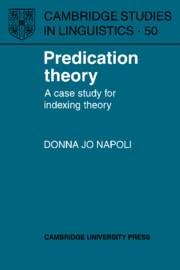Book contents
- Frontmatter
- Contents
- Acknowledgements
- Introduction
- 1 Predicates and theta-role assignment
- 2 The principles of predication coindexing
- 3 Predication coindexing within NP in Italian
- 4 Predication coindexing within NP in English
- 5 A brief look at five more constructions
- 6 An indexing theory encompassing anaphora and predication
- References
- Index of names
- Index of subjects
6 - An indexing theory encompassing anaphora and predication
Published online by Cambridge University Press: 07 October 2009
- Frontmatter
- Contents
- Acknowledgements
- Introduction
- 1 Predicates and theta-role assignment
- 2 The principles of predication coindexing
- 3 Predication coindexing within NP in Italian
- 4 Predication coindexing within NP in English
- 5 A brief look at five more constructions
- 6 An indexing theory encompassing anaphora and predication
- References
- Index of names
- Index of subjects
Summary
We have seen in this book a theory of predication that calls for coindexing between a predicate and its subject role player. In Binding Theory (as in Chomsky 1981) we find a set of conditions under which an item must or may not be coindexed with a c–commanding item. An item that must be so coindexed is an anaphor. The proposal I put forth in this chapter is that the principles developed in chapter two for predication coindexing hold also for anaphor–antecedent coindexing.
Before going into the discussion proper, let me point out that the desirability of a single set of coindexing principles for predication and anaphor coindexing follows from the work of Safir (1985). Safir argues that there should be only one kind of indexing in grammar. His main goal is to do away with the need for superscripting, and use only subscripting. He concentrates on the types of indices that “count” for the binding theory as formulated in Chomsky (1981). And he does not extend his position to predication indexing. This chapter, then, can be seen as an attempt to support Safir's Unity of Indexing Hypothesis by showing that predication coindexing and anaphor–antecedent coindexing, both being obligatory, are instances of one and the same set of indexing principles. If, on the other hand, predication coindexing were an entirely different kind of process from other coindexing processes, Safir's hypothesis would be disconfirmed and we would have to admit a more complicated set of coindexing principles to the grammar.
One might have an immediate objection to the grouping of predication coindexing with anaphor coindexing on the grounds that the latter but not the former involves referential indices.
- Type
- Chapter
- Information
- Predication TheoryA Case Study for Indexing Theory, pp. 273 - 351Publisher: Cambridge University PressPrint publication year: 1989



